There are 7 native species of turtles in Vermont. The Green Mountain State boasts several habitats that are ideal for turtles, including lakes such as Lake Champlain and Lake George, as well as the Hudson River. Vermont’s forests are also the ideal environment for some species of turtle.
Only two of Vermont’s native turtle species are widespread; the Painted turtle, which is Vermont’s state reptile, and the Common Snapping turtle. Other species, such as the Eastern Musk turtle and the Wood turtle, are considered either threatened or of special concern. Here is our guide to the seven native turtles in Vermont.
Turtles in Vermont
1) Common Map Turtle
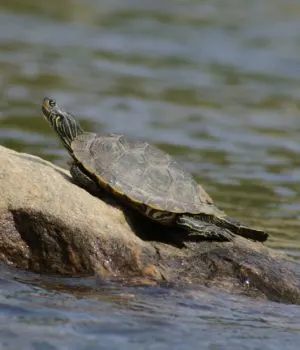
- Experience Level: Beginner
- Family: Emydidae
- Scientific Name: Graptemys Geographica
- Other Names: Northern Map turtle
- Adult Size: Between 4 and 10 ½ inches
- Lifespan: 15 to 20 years
- Average Price Range: Between $20 and $60
- Where To Buy: turtlestore.com
- Recommended Books: Map Turtles and Diamondback Terrapins (Herpetology Series) by W.P. Mara
Common Map turtles have dark brown or olive green shells, and are named for their yellow markings, which resemble the contours of a map. Yellow spots behind the eyes and a lack of red markings separate the Common Map turtle from other subspecies.
In Vermont, Common Map turtles have a status of concern and are confined to extreme western areas near Lake Champlain. They are a mainly aquatic species. They like to bask and are great swimmers.
These turtles are mainly carnivorous, feeding on fish and aquatic invertebrates like crayfish, but also occasionally eat plants.
2) Eastern Musk Turtle
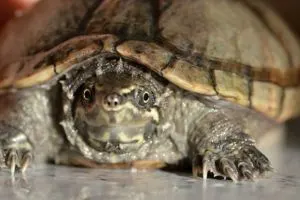
- Experience Level: Intermediate
- Family: Kinosternidae
- Scientific Name: Sternotherus Odoratus
- Other Names: Stinkpot, Common Musk turtle
- Adult Size: Between 4 and 5 inches
- Lifespan: 50 years and over
- Average Price Range: Between $20 and $90
- Where To Buy: theturtlesource.com, undergroundreptiles.com
Eastern Musk turtles are also known as “Stinkpots” due to the strong smell they can release from their musk glands, which they use to protect themselves from predators.
Eastern Musk turtles have dark, unmarked shells. Their heads are also dark, with yellow lines along their cheeks and fleshy tendrils under their chins. They prefer marshy and boggy habitats and are a rare species in Vermont, found in only a few western areas near Lake Champlain.
An omnivorous species, Eastern Musk turtles hunt for prey by scent. They mainly eat mollusks, crayfish, small fish, and tadpoles.
3) Painted Turtles
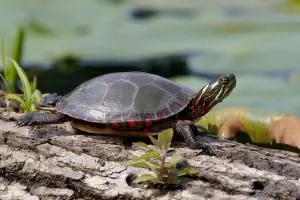
- Experience Level: Beginner
- Family: Emydidae
- Scientific Name: Chrysemys Picta
- Other Names: N/A
- Adult Size: Between 4 and 10 inches
- Lifespan: Between 30 and 50 years
- Average Price Range: Between $20 and $50
Two Painted turtle subspecies are common all across Vermont; the Eastern Painted and the Midland Painted. Vermont’s official State reptile, Painted turtles have dark shells with bold yellow stripe markings on their faces.
Painted turtles like lakes and ponds with soft bottoms. It is often hard to distinguish between Eastern and Midland Painted turtles, but Midlands usually have darker shadows on their plastrons.
Mainly an aquatic species, Painted turtles stay near the water and like to bask. Painted turtles are omnivorous and mainly eat mollusks, frogs, and underwater invertebrates. They must swallow food in the water.
4) Common Snapping Turtle
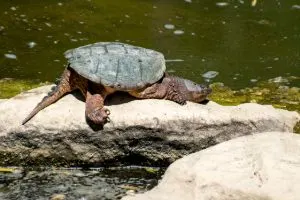
- Experience Level: Intermediate to Expert
- Family: Chelydridae
- Scientific Name: Chelydra Serpentina
- Other Names: Common Snapper, Eastern Snapping turtle, Snapper
- Adult Size: Between 8 and 20 inches
- Lifespan: Between 30 and 50 years
- Average Price Range: Between $20 and $40
- Recommended Books: Snapping Turtle Pet Owners Guide (Ben Team)
Common Snapping turtles are a large, freshwater species that is widespread across Vermont. They can be aggressive, often hissing and biting. They are infrequent baskers and prefer to inhabit larger bodies of slow-moving water.
Identified by their distinctive hooked “beaks”, Common Snappers usually have dark brown or green shells. They also have strong claws and long tails that sport saw-toothed ridges. Their shells are often covered in clumps of moss.
Common Snappers are nocturnal omnivores, mainly eating fish and other aquatic prey. They also consume plants and will even catch and eat small waterbirds if they get close enough.
5) Eastern Spiny Softshell Turtle
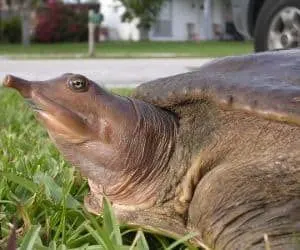
- Experience Level: Intermediate to Expert
- Family: Trionychidae
- Scientific Name: Apalone Spinifera Spinifera
- Other Names: N/A
- Adult Size: 5 to 9 ½ inches for males, 7 to 17 inches for females
- Lifespan: Between 20 and 50 years
- Average Price Range: Between $70 and $280
- Recommended Books: Softshell Turtle owners guide by Ben Team
Eastern Spiny Softshells are the subspecies of Spiny Softshell that are native to Vermont. They are found mainly in scattered north western counties and are considered threatened.
Spiny Softshell turtles have a pancake-like shell with dark circles or rings. Their skin resembles leather but feels a bit like sandpaper. They have long, tapered beaks which they use as snorkels. Their have long necks and sport a pair of stripes on their cheeks.
These turtles are very fast swimmers. They are carnivores and will feed on any crustaceans, invertebrates, and mollusks they can find. They also occasionally eat aquatic plants.
6) Spotted Turtle
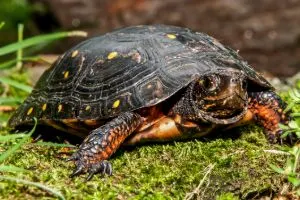
- Experience Level: Intermediate to Expert
- Family: Emydidae
- Scientific Name: Clemmys Guttata
- Other Names: N/A
- Adult Size: Between 4 and 5 inches
- Lifespan: Between 25 and 50 years
- Average Price Range: Between $75 and $100
- Recommended Books: BASICS – Ecology, Husbandry & Breeding Spotted & Wood Turtles (Andreas S. Hennig)
Spotted turtles are an endangered species in Vermont, but their populations are spread across much of the state. They like to bask, often perched on logs at the waters edge. They are semi-aquatic and prefer shallow waters or marshy, boggy habitats.
Spotted turtles are a small, beautiful species. Their smooth shells are black, covered with their eponymous bright yellow dots. Their plastrons are yellow with large black patches of varying sizes on either side.
This omnivorous species often eats invertebrates, crustaceans, mollusks as well as vegetation. As a small species, they make great pets.
7) Wood Turtle

- Experience Level: Intermediate
- Family: Emydidae
- Scientific Name: Glyptemys Insculpta
- Other Names: N/A
- Adult Size: Between 5 ½ to 8 inches
- Lifespan: 40 years in the wild, 58 years in captivity
- Average Price Range: Between $249 and $495
- Where To Buy: The Turtle Source
- Recommended Books: Wood Turtles: A Pet Care Guide for Wood Turtles (Lolly Brown)
Wood turtles are intelligent, inquisitive turtles, but are a species of special concern in Vermont. Their main habitats are woodlands and ponds and their populations are spread across the entire state.
They are can roam up to 300 meters during the day while searching for food. They are omnivores, eating berries, plants, mollusks and earthworms, which they can trick into emerging.
Wood turtles are named because of their shells, feel like they’re made of wood. Their pyramid-shaped scutes look sculpted, with patterning that looks similar to the growth rings on wood. They are mostly brown in color.
Wrapping up
In this list we have covered the 7 native species of turtles in Vermont. From Painted turtles, the official State reptile, to rarer species such as the Eastern Musk turtle, Vermont is home to several fascinating types of turtles.
Did you enjoy this list? Looking to find some of these turtles to add to your reptile collection? Then please feel free to comment below and share your thoughts!
Other nearby states
- Turtles in Maine
- Turtles in Massachusetts
- Turtles in New Hampshire
- Turtles in New York
- Turtles in Rhode Island

Diane
Friday 1st of July 2022
For clarification, is this meant to help people identify turtles for capture? Isn't it enough that we are destroying their homes, so w can ride bikes, as though roads aren't enough of an invasion?
Amy
Wednesday 31st of August 2022
@Brock Yates, this should only be for identification. No sources or prices should be listed because in VT it’s against the law to own these turtles. Also, it’s usually illegal to own animals that are endangered or “of concern”. No, they don’t make good pets if you’re not allowed to own them!
Brock Yates
Friday 1st of July 2022
Good question, conservation is definitely a challenge with human behavior and habits in general. The article is just meant to be informative about what species of turtles are native to the state of Vermont. If you need an identification guide though, you can check this one out: https://www.allturtles.com/turtle-identification/
Thank you for your concern and interest